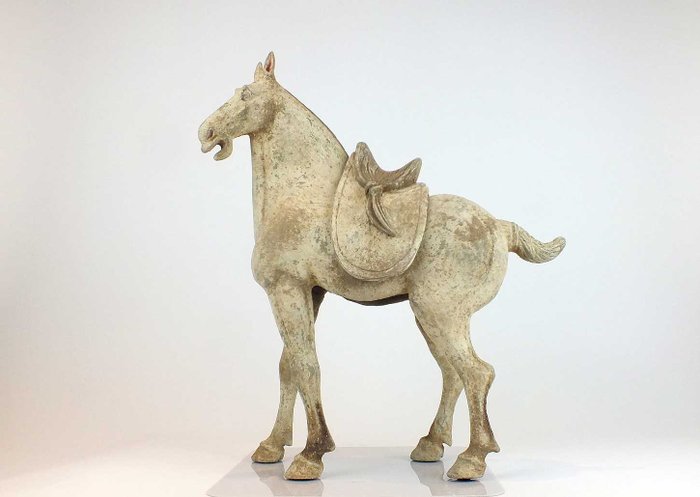
Terracotta 一对精美的彩陶胖妇人像 - 22 cm
编号 83864175

编号 83864175

Tang dynasty (618-907 A.D.)
Height 49 cm., wide 43 cm.
Provenance:
Asian art market
Important Dutch private collection.
Note: It will be professionally packed and safely sent in a wooden crate within 3 working days by FedEx. Shipped with Insurance!
Our Guarantee: The above item is guaranteed to be of the time period and condition as described, has been purchased legally and is legal to buy and sell under all international laws to cultural patrimony.
- All items legal to buy/sell under The Netherlands covering cultural patrimony, and are guaranteed to be as described or your money back.
- The result of the thermoluminescence test, is consistent with the dating of the item, Tang dynasty. Sampling in 3 different points
- The result of the Pre-dose test is consistent with the dating of the item and the test confirms old firing without any kind of artificial x-ray treatments!
The figure shown striding, the head well modelled with flare nostrils and expressive eyes below the picked ears, the horse with hogged mane and head turn slightly to the left, the separate saddle cloth textured in imitation of fur, the figure covered with a white pigment and traces of red pigment.
This is an exceptional large striding horse, unusual in the complementary fashion the position of the horse head and ears. Every line of the horse emphasizes its dramatic neigh- the neck stretched high and forward. The small, lean-featured head, the thick neck and the belly are typical Tang renderings of an Arabian. Also worthy of note is that the widely separated ears, both twisting backward (only few Tang horses were made like this and could be found in the present market), reveal its spirit.
Additional Information:
Tang Dynasty
National unification during the Tang dynasty brought about centuries of social stability and economic prosperity. Ceramic art evolved further towards maturity and important kiln centres emerge across the country.
The repertoire of mortuary objects in Tang tombs closely followed those of earlier periods. The majority was still made of pottery clay and came in many forms and styles, which illustrate the evolution and traits of Tang ceramic art. These objects can broadly be divided into five categories namely tomb guardians, guards of honour, attendants, animals, and utilitarian wares.
Tang dynasty tomb figures are pottery figures of people and animals made in the Tang dynasty of China (618–906) as grave goods to be placed in tombs. There was a belief that the figures represented would become available for the service of the deceased in the afterlife. The figures are made of moulded earthenware with colour generally being added, though often not over the whole figure, or in naturalistic places. Where the colouring was in paint it has often not survived, but in many cases, it was in sancai ("three-colour") ceramic glaze, which has generally lasted well.
The figures, called mingqui in Chinese, were most often of servants, soldiers (in male tombs) and attendants such as dancers and musicians, with many no doubt representing courtesans. In burials of people of high rank there may be soldiers and officials as well. The animals are most often horses, but there are surprising numbers of both Bactrian camels and their Central Asian drivers, distinguished by thick beards and hair, and their facial features. The depictions are realistic to a degree unprecedented in Chinese art, and the figures give archaeologists much useful information about life under the Tang. There are also figures of the imaginary monster "earth spirits" and the fearsome human Lokapala (or tian wang), both usually in pairs and acting as tomb guardians to repel attacks by both spirits and humans. Sets of the twelve imaginary beasts of the Chinese Zodiac are also found, usually unglazed.
The most common animals, and the most likely to be large and carefully modelled and decorated, are horses and camels. Both sorts range from animals without harness and saddlery to those with elaborately detailed trappings, and carrying riders or, in the case of camels, heavy loads of goods.
The graceful ladies with plump faces and bodies (so called Fat ladies), the smartly dressed civil officials, the mighty warriors, the horses with saddles and accessories, as well as camels and non - Chinese figurines are all results of the potter’s keen observation and superb virtuosity. They allow us to visualise life in China more than a millennium ago.
- A Certificate of Authenticity from Becker Antiques (specialist in Chinese pottery since 1969, Amsterdam) will accompany the item.
Condition: Very good condition. Wear consistent with the age, some loss of color. Please be advised that all ancient Chinese pottery objects had been buried in tombs and are excavated from there. Therefore, they can always have some restorations. Also worth of note is that the item is more than 1200 years old.
Important information.
The seller guarantees that he is entitled to ship this lot.
It will be professionally packed and safely sent in a wooden crate by FedEx.
Buyers are responsible for import regulation and restrictions of their own country.
#MorganNiquetCollection